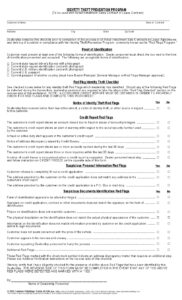In today’s digital age, online fraud is a growing concern for businesses of all sizes. A well-defined fraud prevention and detection policy is essential for safeguarding your company against fraudulent activities and minimizing financial losses. This template provides a comprehensive framework for establishing a robust fraud prevention and detection program, enabling you to proactively identify, investigate, and mitigate fraudulent transactions.
Fraudulent activities can take many forms, including unauthorized access to customer accounts, identity theft, payment fraud, and phishing scams. By implementing effective fraud prevention measures, you can protect your business and customers from these malicious attempts. A comprehensive fraud prevention and detection policy serves as a roadmap for your team to follow in identifying and addressing fraud risks, ensuring the integrity of your business operations.
Essential Elements of a Fraud Prevention and Detection Policy
1. Clearly Define Fraud:
The first step in creating an effective fraud prevention and detection policy is to clearly define what constitutes fraud. This includes identifying specific types of fraudulent activities that your policy will address, such as identity theft, unauthorized transactions, and phishing scams. Clearly defining fraud ensures that all employees and stakeholders have a common understanding of what constitutes fraudulent behavior.
2. Establish Roles and Responsibilities:
Clearly define the roles and responsibilities of individuals and teams involved in fraud prevention and detection. This includes assigning responsibilities for fraud risk assessment, transaction monitoring, investigation, and reporting. Establishing clear roles and responsibilities ensures that everyone knows their duties and can work together effectively to combat fraud.
3. Implement Fraud Risk Assessment:
Regularly assess your business’s fraud risks to identify potential vulnerabilities. This assessment should consider factors such as the nature of your business, customer base, payment methods, and online presence. By conducting thorough risk assessments, you can prioritize your fraud prevention efforts and allocate resources accordingly.
4. Utilize Fraud Detection Tools and Technologies:
Leverage technology and fraud detection tools to monitor transactions and identify suspicious activities. These tools can analyze large volumes of data, identify anomalies, and flag potentially fraudulent transactions. By implementing robust fraud detection mechanisms, you can proactively detect and prevent fraudulent attempts.
Implementing and Monitoring Your Fraud Prevention and Detection Policy
1. Training and Awareness:
Train your employees on the fraud prevention and detection policy and ensure they understand their roles and responsibilities. Educate them on common fraud schemes, red flags to look for, and the proper procedures for reporting suspicious activities. Ongoing training and awareness programs help keep employees vigilant and proactive in identifying and preventing fraud.
2. Continuous Monitoring and Review:
Continuously monitor the effectiveness of your fraud prevention and detection policy and make adjustments as needed. Regularly review transaction patterns, fraud detection alerts, and investigation outcomes to identify trends and emerging fraud risks. Based on these insights, update your policy and procedures to stay ahead of evolving fraud threats.
3. Incident Response and Investigation:
Establish a clear incident response plan for handling suspected fraudulent activities. This plan should outline the steps to take when fraud is detected, including investigation procedures, evidence collection, and reporting to appropriate authorities. Timely and thorough investigations help deter fraudsters and minimize losses.
4. Reporting and Communication:
Create a central repository for recording and tracking fraud incidents. This repository should include details of fraudulent transactions, investigation outcomes, and corrective actions taken. Regularly communicate fraud trends, emerging threats, and policy updates to relevant stakeholders, including employees, management, and regulatory authorities.
Conclusion
Implementing a robust fraud prevention and detection policy template is crucial for protecting your business from fraudulent activities. By clearly defining fraud, establishing roles and responsibilities, conducting fraud risk assessments, and leveraging technology, you can effectively identify, investigate, and mitigate fraud risks. Regular training, continuous monitoring, and incident response mechanisms ensure that your policy remains effective in combating evolving fraud threats.
By adopting a proactive approach to fraud prevention and detection, you can safeguard your business, protect customer data, and maintain the integrity of your operations in the digital age.
FAQ: Fraud Prevention and Detection Policy Template
What is a fraud prevention and detection policy template?
A fraud prevention and detection policy template is a comprehensive framework that provides guidance and instructions for establishing a robust fraud prevention and detection program within an organization.
What are the key elements of a fraud prevention and detection policy?
Key elements of a fraud prevention and detection policy include clearly defining fraud, establishing roles and responsibilities, implementing fraud risk assessments, and utilizing fraud detection tools and technologies.
How can I implement and monitor a fraud prevention and detection policy?
To implement and monitor a fraud prevention and detection policy, you should conduct training and awareness programs, continuously monitor the policy’s effectiveness, establish an incident response plan, and create a central repository for recording and tracking fraud incidents.
How can I ensure my fraud prevention and detection policy remains effective?
To ensure the effectiveness of your fraud prevention and detection policy, you should regularly review and update the policy based on emerging fraud risks, conduct ongoing training and awareness programs for employees, and continuously monitor and analyze fraud trends and patterns.
What are some common types of fraud that businesses should be aware of?
Common types of fraud that businesses should be aware of include identity theft, unauthorized transactions, payment fraud, phishing scams, and counterfeit goods.

